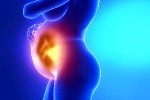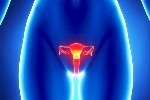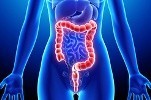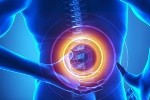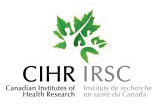Luteal Phase in Menstrual cycle
A woman’s menstrual cycle consists of different phases. After ovulation the luteal phase starts and lasts until the next menstruation. It is named after the corpus luteum, the yellow body. This consists of the remnants of the ovulated egg in the ovary and produces different hormones, including progesterone, which is an important and unique reproduction hormone. It is the main product of the corpus luteum, dominant in the luteal phase cycle, and in pregnancy, its secretion continues and increases ensuring maintenance of the early conception.
Progesterone prepares the endometrium for pregnancy by stimulating proliferation in response to human chorionic gonadotropin (hCG), which is produced by the corpus luteum. This occurs in the luteal phase of the menstrual cycle.
Following conception and implantation, the developing blastocyst secretes human chorionic gonadotrophin (hCG). The role of hCG is to maintain the corpus luteum and its secretions. Normal luteal function is essential for maintaining pregnancy—several studies have shown that removal of the corpus luteum during early pregnancy results in complete abortion (1, 2).
Luteal Phase Defect
Definition
A defective luteal phase (DLP) results from a relative deficiency in secretion of progesterone by the corpus luteum. A single plasma progesterone level of 10 ng/ml in the luteal phase or a mean concentration of plasma progesterone of 12 - 1 3 ng/ml over 4 days at mid-luteal phase seems to exclude an inadequacy of corpus luteum function.
The term has been applied both to a short interval (< 11 days) between ovulation and menstruation, with relatively normal peak values of progesterone, and, more commonly, to a luteal phase of normal length with lower then normal progesterone levels. Both result in inadequate stimulation of the endometrium. A related, but rare, condition is the absence of progesterone receptors in the endometrium (2).
Incidence
An inadequate luteal phase may occur in isolated cycles in normal women, and only when the defect is repetitive is it thought to be a significant factor in infertility. Approximately 3-4% of
infertile women will be diagnosed as having an inadequate luteal phase (Wentz, 1982). The incidence may be higher in women with histories of habitual abortion (4-10%) (3).
Diagnosis
The diagnosis can be approached in a number of ways. The basal body temperature chart may be biphasic, but the duration of the rise may be < 11 days. A diagnosis made on the basis of basal
temperature charts should be corroborated by endometrial biospy, which remains the classical way to diagnose an inadequate luteal phase. Because of the discomfort and expense associated with
endometrial biopsy, attention has turned to direct measurements of plasma progesterone levels to rule out an inadequate luteal phase.
A single plasma progesterone level of 10 ng/ml in the luteal phase (Hull et al., 1982) or a mean concentration 12-13 ng/ml of plasma progesterone over the 4 days from +5 to +8 of the luteal phase
(after the LH surge) (4) exclude inadequacy of corpus luteum function.
In conclusion, if the basal temperature chart shows a normal luteal phase length, and if two serum progesterone values measured near the midluteal phase in one cycle are both above 14 ng/ml, it is
unlikely that the patient is infertile because of luteal phase inadequacy.
Treatment of Chinese medicine and Acupuncture for Defective Luteal Phase (DLP)
References
According to reports, LPD affects approximately 10% of women with infertility. Currently, Clomiphene and progesterone are mainly used in Western medicine for LPD; however, the clinical outcome was not ideal.
In Chinese medicine, this condition was recorded as "earlier period", "delayed period", "scanty menstruation", "failure to get pregnant", "fetal leakage", "fetal restlessness", or "miscarriage". Modern medicine has proven that LPD is associated with insufficient gonadotrophin.
Numerous data have suggested that acupuncture can regulate functional disorders of the hypothalamuspituitary-sexual axis, and thus elevate P value and E2 but reduce FSH contents (5-12).
As the crossing point of the Conception Vessel with Three Yin Meridians of Foot and the crossing point of Three Yin Meridians of Foot, Guanyuan (CV 4) and Sanyinjiao (SP 6) work together to nourish yin, dredge meridians, balance yin and yang and regulate the Thoroughfare and Conception Vessels.
Also,Sanyinjiao (SP 6) works for irregular menstruation and resultant infertility. Dahe (KI 12) benefits the kidney and facilitates the Thoroughfare Vessel. Shenshu (BL 23) and Ciliao (BL 32) warm kidney-yang. Zusanli (ST 36) strengthens the spleen and regulates qi and blood. Combination of the above points unblocks meridians, harmonizes the Thoroughfare and Conception Vessels and increases, tonifies the kidney, strengthens the spleen thus maximizes the chances of conception.
1. P.G.Crosignani., The defective luteal phase, Human Reproduction vol.3 no.2 pp. 157-160, 1988
2. Jones,G.S. (1949) Some newer aspects of the management of infertility. J. Am. Med. Assoc., 141, 1123-1126.
3. Murthy,Y.S., Arronet.G.H. and Parekh.M.C. (1970) Luteal phase inadequacy. Obstet. Gynecol., 36, 758—762.
4. Lenton.E. (1983) Luteal-phase insufficiency. In Harrison,R.F., BonnarJ. and Thompson,W. (eds), Fertility and Sterility, XI. World Congress on Fertility and Sterility, Dublin.
5. Liu WC, Zhang BS, Zhang LM. Effect of acupuncture on serotonin in women with dysfunctional uterine bleeding. Zhong Guo Zhen Jiu, 1991, 11 (5): 37-38.
6. Du CY. Observations on the curative effect of acupuncture on chloasma. Shang Hai Zhen Jiu Za Zhi, 2007, 26(4): 14-15.
7. Yu YC. Study on acupuncture and Chinese medicine for ovarian stimulation. Zhong Guo Zhong Xi Yi Jie He Za Zhi, 1985, 5 (4): 201.
8. Cheng LN, Du GZ, Chen BY. The biochemical mechanism of electroacupuncture regulation of dysfunctional hypothalamic-pituitary-ovarian axis in ovariectomized rats. Shang Hai Zhen Jiu Za Zhi, 2001,
20(6): 32-34.
9 Guan X, Wang YJ. Research overview on acupuncture for endocrine hormone regulation. Zhong Guo Zhen Jiu, 1997, 17 (5): 315.
Contact Us
Chalmers Medical Building
328 Hwy 7 East Suite 201,
Richmond Hill ON L4B 3P7
Tel: 416 399-3888
E-mail: info@aahclinic.com
Conditions Treated
Effective Herbal Therapy for Inflammatory Bowel Disease
NO Surgery!
Carolyn XU Treats Ulcer Colitis Successfully
Considering Therapy?
Resource Links
References
Donation
Great things happen when you put your heart into it.
Click Here to Send us your request
Tips
Questions about your first appointment or if your insurance will cover the cost? Find more information below.


